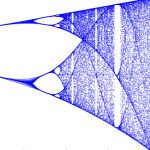 Using Python to visualize chaos, fractals, and self-similarity to better understand the limits of knowledge and prediction. Download/cite the article here and try pynamical yourself.
Using Python to visualize chaos, fractals, and self-similarity to better understand the limits of knowledge and prediction. Download/cite the article here and try pynamical yourself.
Chaos theory is a branch of mathematics that deals with nonlinear dynamical systems. A system is just a set of interacting components that form a larger whole. Nonlinear means that due to feedback or multiplicative effects between the components, the whole becomes something greater than just adding up the individual parts. Lastly, dynamical means the system changes over time based on its current state. In the following piece (adapted from this article), I break down some of this jargon, visualize interesting characteristics of chaos, and discuss its implications for knowledge and prediction.
Chaotic systems are a simple sub-type of nonlinear dynamical systems. They may contain very few interacting parts and these may follow very simple rules, but these systems all have a very sensitive dependence on their initial conditions. Despite their deterministic simplicity, over time these systems can produce totally unpredictable and wildly divergent (aka, chaotic) behavior. Edward Lorenz, the father of chaos theory, described chaos as “when the present determines the future, but the approximate present does not approximately determine the future.”
The Logistic Map
How does that happen? Let’s explore an example using the famous logistic map. This model is based on the common s-curve logistic function that shows how a population grows slowly, then rapidly, before tapering off as it reaches its carrying capacity. The logistic function uses a differential equation that treats time as continuous. The logistic map instead uses a nonlinear difference equation to look at discrete time steps. It’s called the logistic map because it maps the population value at any time step to its value at the next time step:
$latex x_{t+1} = r x_t (1-x_t)$
This equation defines the rules, or dynamics, of our system: x represents the population at any given time t, and r represents the growth rate. In other words, the population level at any given time is a function of the growth rate parameter and the previous time step’s population level. If the growth rate is set too low, the population will die out and go extinct. Higher growth rates might settle toward a stable value or fluctuate across a series of population booms and busts.
As simple as this equation is, it produces chaos at certain growth rate parameters. I’ll explore this below. This demo uses the Python pynamical package and all my code is in this GitHub repo (see article for more on this). First, I’ll run the logistic model for 20 time steps (I’ll henceforth call these recursive iterations of the equation generations) for growth rate parameters of 0.5, 1.0, 1.5, 2.0, 2.5, 3.0, and 3.5. Here are the values we get:
The columns represent growth rates and the rows represent generations. The model always starts with a population level of 0.5 and it’s set up to represent population as a ratio between 0 (extinction) and 1 (the maximum carrying capacity of our system).
System Behavior and Attractors
If you trace down the column under growth rate 1.5, you’ll see the population level settles toward a final value of 0.333… after 20 generations. In the column for growth rate 2.0, you’ll see an unchanging population level across each generation. This makes sense in the real world – if two parents produce two children, the overall population won’t grow or shrink. So the growth rate of 2.0 represents the replacement rate.
Let’s visualize this table of results as a line chart:
Here you can easily see how the population changes over time, given different growth rates. The blue line represents a growth rate of 0.5, and it quickly drops to zero. The population dies out. The cyan line represents a growth rate of 2.0 (remember, the replacement rate) and it stays steady at a population level of 0.5. The growth rates of 3.0 and 3.5 are more interesting. While the yellow line for 3.0 seems to be slowly converging toward a stable value, the gray line for 3.5 just seems to bounce around.
An attractor is the value, or set of values, that the system settles toward over time. When the growth rate parameter is set to 0.5, the system has a fixed-point attractor at population level 0 as depicted by the blue line. In other words, the population value is drawn toward 0 over time as the model iterates. When the growth rate parameter is set to 3.5, the system oscillates between four values, as depicted by the gray line. This attractor is called a limit cycle.
But when we adjust the growth rate parameter beyond 3.5, we see the onset of chaos. A chaotic system has a strange attractor, around which the system oscillates forever, never repeating itself or settling into a steady state of behavior. It never hits the same point twice and its structure has a fractal form, meaning the same patterns exist at every scale no matter how much you zoom into it.
Bifurcations and the Path to Chaos
To show this more clearly, let’s run the logistic model again, this time for 200 generations across 1,000 growth rates between 0.0 to 4.0. When we produced the line chart above, we had only 7 growth rates. This time we’ll have 1,000 so we’ll need to visualize it in a different way, using something called a bifurcation diagram:
Think of this bifurcation diagram as 1,000 discrete vertical slices, each one corresponding to one of the 1,000 growth rate parameters (between 0 and 4). For each of these slices, I ran the model 200 times then threw away the first 100 values, so we’re left with the final 100 generations for each growth rate. Thus, each vertical slice depicts the population values that the logistic map settles toward for that parameter value. In other words, the vertical slice above each growth rate is that growth rate’s attractor.
For growth rates less than 1.0, the system always collapses to zero (extinction). For growth rates between 1.0 and 3.0, the system always settles into an exact, stable population level. Look at the vertical slice above growth rate 2.5. There’s only one population value represented (0.6) and it corresponds to where the magenta line settles in the line chart shown earlier. But for some growth rates, such as 3.9, the diagram shows 100 different values – in other words, a different value for each of its 100 generations. It never settles into a fixed point or a limit cycle.
So, why is this called a bifurcation diagram? Let’s zoom into the growth rates between 2.8 and 4.0 to see what’s happening:
At the vertical slice above growth rate 3.0, the possible population values fork into two discrete paths. At growth rate 3.2, the system essentially oscillates exclusively between two population values: one around 0.5 and the other around 0.8. In other words, at that growth rate, applying the logistic equation to one of these values yields the other.
Just after growth rate 3.4, the diagram bifurcates again into four paths. This corresponds to the gray line in the line chart we saw earlier: when the growth rate parameter is set to 3.5, the system oscillates over four population values. Just after growth rate 3.5, it bifurcates again into eight paths. Here, the system oscillates over eight population values.
The Onset of Chaos
Beyond a growth rate of 3.6, however, the bifurcations ramp up until the system is capable of eventually landing on any population value. This is known as the period-doubling path to chaos. As you adjust the growth rate parameter upwards, the logistic map will oscillate between two then four then eight then 16 then 32 (and on and on) population values. These are periods, just like the period of a pendulum.
By the time we reach growth rate 3.9, it has bifurcated so many times that the system now jumps, seemingly randomly, between all population values. I only say seemingly randomly because it is definitely not random. Rather, this model follows very simple deterministic rules yet produces apparent randomness. This is chaos: deterministic and aperiodic.
Let’s zoom in again, to the narrow slice of growth rates between 3.7 and 3.9:
As we zoom in, we begin to see the beauty of chaos. Out of the noise emerge strange swirling patterns and thresholds on either side of which the system behaves very differently. Between the growth rate parameters of 3.82 and 3.84, the system moves from chaos back into order, oscillating between just three population values (approximately 0.15, 0.55, and 0.95). But then it bifurcates again and returns to chaos at growth rates beyond 3.86.
Fractals and Strange Attractors
In the plot above, the bifurcations around growth rate 3.85 look a bit familiar. Let’s zoom in to the center one:
Incredibly, we see the exact same structure that we saw earlier at the macro-level. In fact, if we keep zooming infinitely in to this plot, we’ll keep seeing the same structure and patterns at finer and finer scales, forever. How can this be?
I mentioned earlier that chaotic systems have strange attractors and that their structure can be characterized as fractal. Fractals are self-similar, meaning that they have the same structure at every scale. As you zoom in on them, you find smaller copies of the larger macro-structure. Here, at this fine scale, you can see a tiny reiteration of the same bifurcations, chaos, and limit cycles we saw in the first bifurcation diagram of the full range of growth rates.
Another way to visualize this is with a phase diagram (or Poincaré plot), which plots the population value at generation t + 1 on the y-axis versus the population value at t on the x-axis. I delve into 2-D, 3-D, and animated phase diagrams in greater detail in a subsequent post.
Remember that our model follows a simple deterministic rule, so if we know a certain generation’s population value, we can easily determine the next generation’s value:
The phase diagram above on the left shows that the logistic map homes in on a fixed-point attractor at 0.655 (on both axes) when the growth rate parameter is set to 2.9. This corresponds to the vertical slice above the x-axis value of 2.9 in the bifurcation diagrams shown earlier. The plot on the right shows a limit cycle attractor. When the growth rate is set to 3.5, the logistic map oscillates across four points, as shown in this phase diagram (and in the bifurcation diagrams from earlier).
Here’s what happens when these period-doubling bifurcations lead to chaos:
The plot on the left depicts a parabola formed by a growth rate parameter of 3.9. The plot on the right depicts 50 different growth rate parameters between 3.6 and 4.0. This range of parameters represents the chaotic regime: the range of parameter values in which the logistic map behaves chaotically. Each growth rate forms its own curve. These parabolas never overlap, due to their fractal geometry and the deterministic nature of the logistic equation.
Strange attractors are revealed by these shapes: the system is somehow oddly constrained, yet never settles into a fixed point or a steady oscillation like it did in the earlier phase diagrams for r=2.9 and r=3.5. It just bounces around different population values, forever, without ever repeating a value twice.
Chaos vs Randomness
These phase diagrams depict 2-dimensional state space: an imaginary space that uses system variables as its dimensions. Each point in state space is a possible system state, or in other words, a set of variable values. Phase diagrams are useful for revealing strange attractors in time series data (like that produced by the logistic map), because they embed this 1-dimensional data into a 2- or even 3-dimensional state space.
Indeed, it can be hard to tell if certain time series are chaotic or just random when you don’t fully understand their underlying dynamics. Take these two as an example:
Both of the lines seem to jump around randomly. The blue line does depict random data, but the red line comes from our logistic model when the growth rate is set to 3.99. This is deterministic chaos, but it’s hard to differentiate it from randomness. So, let’s visualize these same two data sets with phase diagrams instead of line charts:
Now we can see our chaotic system (in red, above) constrained by its strange attractor. In contrast, the random data (in blue, above) just looks like noise. This is even more compelling in the 3-D phase diagram that embeds our time series into a 3-dimensional state space by depicting the population value at generation t + 2 vs the value at generation t + 1 vs the value at t.
Let’s plot the rest of the logistic map’s chaotic regime in 3-D. This is an animated, 3-D version of the 2-D rainbow parabolas we saw earlier:
In three dimensions, the beautiful structure of the strange attractor is revealed as it twists and curls around its 3-D state space. This structure demonstrates that our apparently random time series data from the logistic model isn’t really random at all. Instead, it is aperiodic deterministic chaos, constrained by a mind-bending strange attractor.
The Butterfly Effect
Chaotic systems are also characterized by their sensitive dependence on initial conditions. They don’t have a basin of attraction that collects nearby points over time into a fixed-point or limit cycle attractor. Rather, with a strange attractor, close points diverge over time.
This makes real-world modeling and prediction difficult, because you must measure the parameters and system state with infinite precision. Otherwise, tiny errors in measurement or rounding are compounded over time until the system is thrown drastically off. It was through one such rounding error that Lorenz first discovered chaos. Recall his words at the beginning of this piece: “the present determines the future, but the approximate present does not approximately determine the future.”
As an example of this, let’s run the logistic model with two very similar initial population values:
Both have the same growth rate parameter, 3.9. The blue line represents an initial population value of 0.5. The red line represents an initial population of 0.50001. These two initial conditions are extremely similar to one another. Accordingly their results look essentially identical for the first 30 generations. After that, however, the minuscule difference in initial conditions starts to compound. By the 40th generation the two lines show little in common.
If our knowledge of these two systems started at generation 50, we would have no way of guessing that they were almost identical in the beginning. With chaos, history is lost to time and prediction of the future is only as accurate as your measurements. In real-world chaotic systems, measurements are never infinitely precise, so errors always compound, and the future becomes entirely unknowable given long enough time horizons.
This is famously known as the butterfly effect: a butterfly flaps its wings in China and sets off a tornado in Texas. Small events compound and irreversibly alter the future of the universe. In the line chart above, a tiny fluctuation of 0.00001 makes an enormous difference in the behavior and state of the system 50 generations later.
The Implications of Chaos
Real-world chaotic and fractal systems include leaky faucets, ferns, heart rates, and random number generators. Many scholars have studied the implications of chaos theory for the social sciences, cities, and urban planning. Chaos fundamentally indicates that there are limits to knowledge and prediction. Some futures may be unknowable with any precision. Deterministic systems can produce wildly fluctuating and non-repeating behavior. Interventions into a system may have unpredictable outcomes even if they initially change things only slightly, as these effects compound over time.
During the 1990s, complexity theory grew out of chaos theory and largely supplanted it as an analytic frame for social systems. Complexity draws on similar principles but in the end is a very different beast. Instead of looking at simple, closed, deterministic systems, complexity examines large open systems made of many interacting parts. Unlike chaotic systems, complex systems retain some trace of their initial conditions and previous states, through path dependence. They are unpredictable, but in a different way than chaos: complex systems have the ability to surprise through novelty and emergence. But that is a tale for another day.
You can download/cite the paper this post is adapted from. I delve into 2-D, 3-D, and animated phase diagrams in greater detail in this post, and I explain how to create animated 3-D data visualizations in Python in this post. All of the code that I used to run the model and produce these graphics is available in this GitHub repo. All of its functionality is thoroughly commented, but leave a note if you have any questions or suggestions. Feel free to play with it and explore the beauty of chaos.
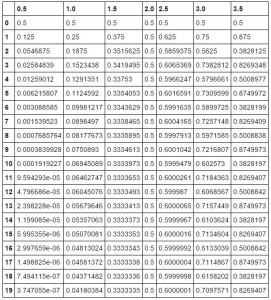

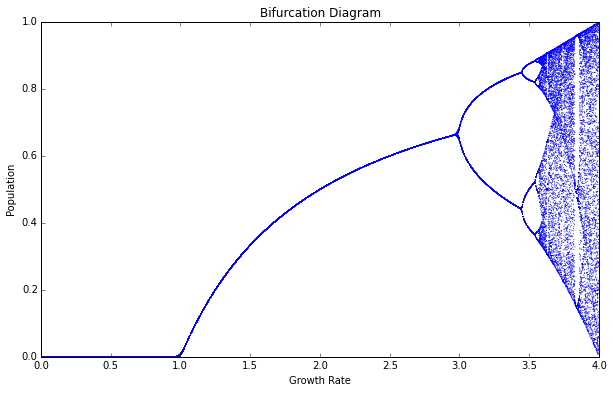



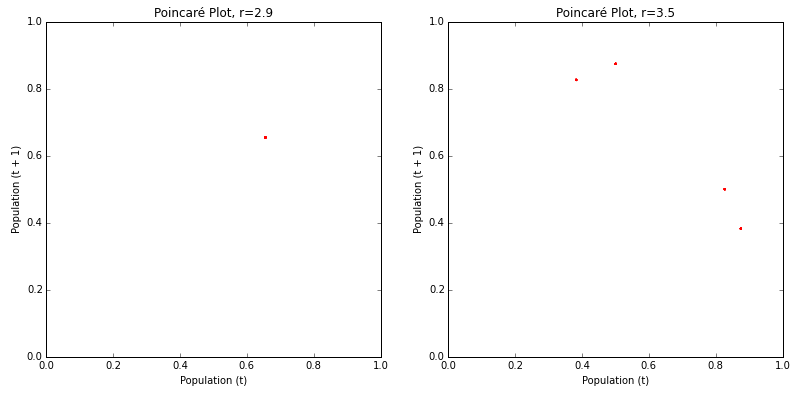

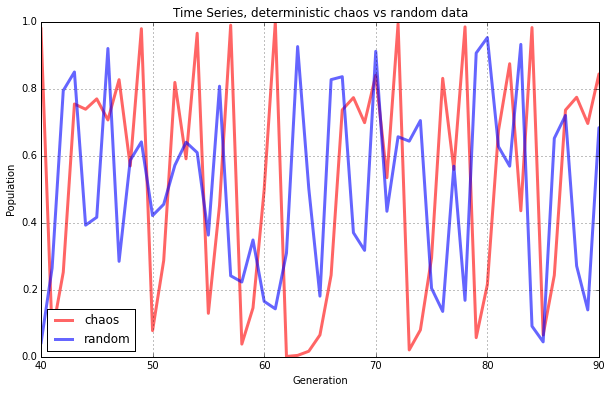
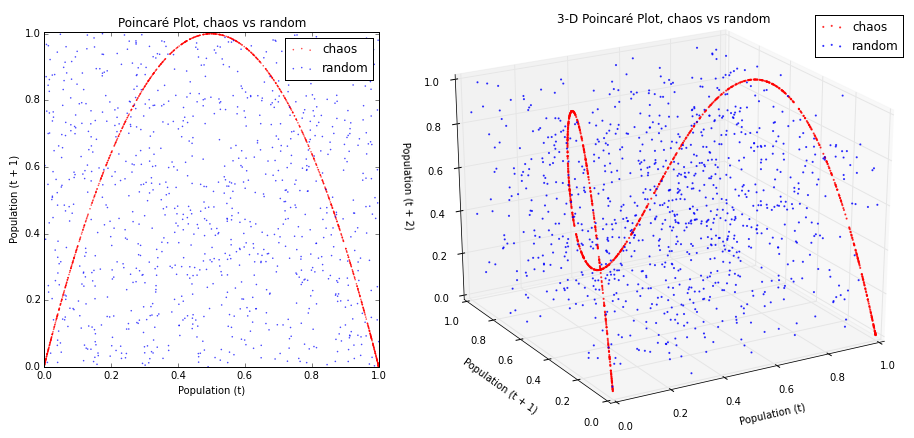
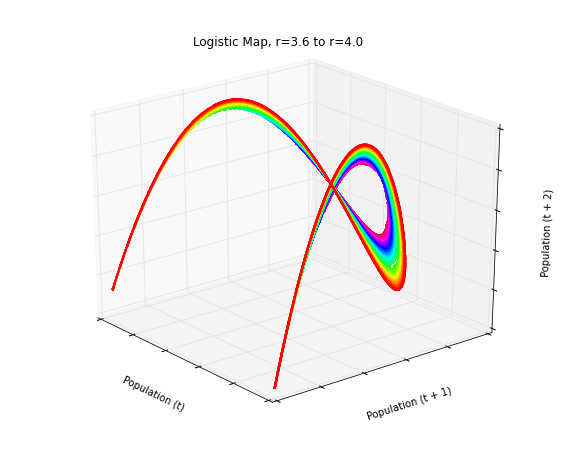
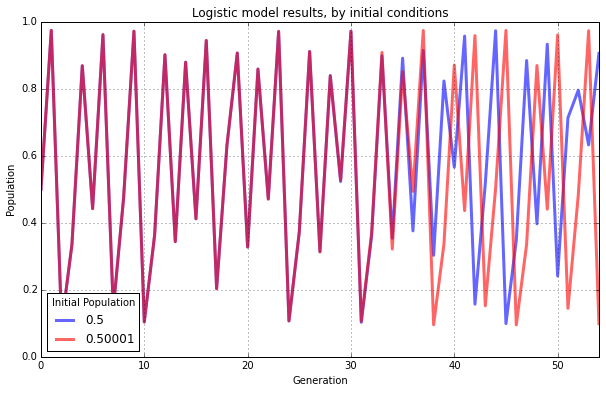
33 replies on “Chaos Theory and the Logistic Map”
Great stuff! I recently picked up James Gleicks’ “Chaos: A New Science”. He goes into the logistic map in some detail, but I feel like I have a much clearer understanding of the logistic map after reading this.
Great article! However dynamic systems are not just systems that change over time. A dynamic system is a system which evolution over time depends on its inputs (if any) and the value of its state. This is why initial conditions need to be specified. In the particular case of chaotic systems the evolution of the system is greatly affected by the value of the initial conditions.
Excellent point. I edited that introductory sentence to make that clearer.
The notion of dependence on initial conditions is critical and noteworthy. So is sensitivity.
In a world of presumed cause and effect, I am often surprised by outcomes from events that are assumed to be insignificant.
Strangely, the law formally recognizes the notion of insignificance with pronouncements such as ’cause too remote’ for events that, with linear hindsight, appear to be so predictable that we might as well have planned them. Some politicians seem to thrive on this retrospection by blaming others for precedent conditions which were latterly, still quite controllable.
Nice summary, by the way.
[…] Moderate: http://geoffboeing.com/2015/03/chaos-theory-logistic-map/ […]
[…] Moderate: http://geoffboeing.com/2015/03/chaos-theory-logistic-map/ […]
[…] time-dependent behaviour and in a non-linear manner. A special class of such systems also exhibit chaos, which is defined as sensitive dependence upon initial conditions. There are great textbooks […]
Thank you. This post is both very well-written and a valuable introduction to some of the more important aspects of the chaos theory.
Thank you for this great article. It is very well written.
Crystal clear and very helpful, thank you!
excellent post that anybody can understand about chaos systems.
thank you!
what is initial value of logistic mapping Z(0) if we use r = 4.0, Z(t+1) = 4xZ(t)x(1-Z(t))
I assume you’re using “x” to represent multiplication? That is an awful practice best behind left in high school
Also Z(0) is your starting value/initial population. It does not make sense to derive this, you use the formula you quoted to model evolution given initial conditions
Also your expression for Z(t+1) is independent of r.. so your choice of r is irrelevant
Use basic algebra to refactor your expression to get an expression for Z(t) as a function of Z(t+1), then you could find Z(0) if you were given a Z(1) but I cannot imagine a situation where this would happen
Thank you for the valuable details and explanations
Very helpful!!!! I was left with the hardest topic for a speech and luckily I found this!
Thank you so much!
[…] G. (2015) Chaos Theory and the Logistic Map. Available from: http://geoffboeing.com/2015/03/chaos-theory-logistic-map/ [Accessed 20 March […]
Can you explain how the specific relative scale between a butterfly flutter and a tornado is determined in the original hypothesis; presuming that it represents a fairly precise limit in the iteration; and why its appearance is not simply an artifact of a compounded phase disparity between two aspects of a common unitary universal system or space?
how can I analysis of stability for biped walking robot by bifucation digram and poincare map in MATLAB?
Hi, I really like the article, thanks
Do you have plot for lorentz and rossler attractor?
Lorenz system attractor here: http://geoffboeing.com/2016/12/animating-lorenz-attractor-python/
[…] oscillate between two different states, then four different states, then 8, 16, 32… and so on. “This is known as the period-doubling path to chaos,” and “the ratio between the values where the period doubles ends up approaching the […]
It might be helpful for some if you were to note that Period Doubling refers to how frequently the pattern of a specific cycle recurs, where the number of oscillations between recurrences doubles for each successive interval of recurrence. Moreover, you might want to note that the Logistic Map is a mathematical construct which has not been found in the behavior of real-life biological systems, even though it is purported to reflect the cyclical (generational) growth of populations where the value for “r” reflects a narrow range of parametric influences that deterministically lead to a chaotic pattern of oscillating population numbers.
Why is the entire universe built of composites, one next to one, there is no unit without composite, NO.Absolute.ONE?
What’s going on with this?
Please help me with codes for encryption and Decryption using logistic map for MTech project.
Thanks
[…] do see Prof. Geoff Boeing’s blog post: “Chaos theory and the logistic map” [^]. Boeing is a professor of urban planning, and not of engineering, physics, CS, or maths. But it is […]
Thanks for a very well written and interesting article. I enjoyed it so much I tried to recreate the start of it in R! https://github.com/cj-holmes/my-first-chaos-theory
I learn much from this article.
Thanks a lot for this posting.
Mr. Boeing, this is a very nice summary. Could you tell me to what level of precision are these calculations made and does changing the level of precision to a very high level change the randomness picture or possibly eliminate some of it.
[…] one is from a great post of USC professor Geoff Boeing. It shows several possible behaviors of the population for different […]
Hi Geoff,
I can’t make sense of the following paragraph: “For each of these slices, I ran the model 200 times then threw away the first 100 values, so we’re left with the final 100 generations for each growth rate”. I think of it as you ran the logistic map with 200 iterations with a fixed value r to get the values x1, x2 .. x200. Then, you draw the result of the last iteration x200, or do you draw all iterated values from x101..x200 (without iterations x1..x100)?
[…] Someone did all the above (and better/more) in Python […]
Is there possibly an animated 3-D Poincare Plot presentation about when the growth rate is not fixed at 3.99 but is growing?
[…] Credit: Geoff Boeing. […]